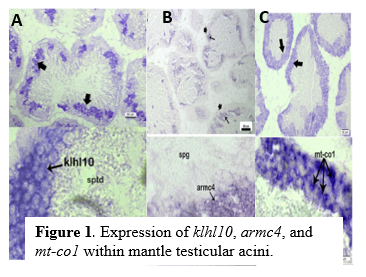SPATIAL EXPRESSION PATTERNING OF SELECT GENES ASSOCIATED WITH EARLY SPERMATOGENESIS/SPERMIOGENESIS IN Mytilus edulis
The spatial expression patterns of three genes (kelch-like protein homolog 10 (klhl10); armadillo repeat-containing protein 4 isoform X2 (armc4); mitochondria cytochrome oxidase I (mt-co1)) important during spermatogenesis/spermiogenesis were localized to cells within the acini of male Mytilus edulis using nonisotopic in situ hybridization and ribo-probes based on differentially expressed sequences derived from mantle RNA-seq libraries.
Hybridization signals for all three genes were associated with a layer of cells near the outer wall of the testicular acini. This cell layer is known to contain developing spermatogonia, spermatocytes, and spermatids with mature spermatozoa at the center of the acini.
Klhl10 was detected in immature spermatogonia/spermatocytes localized near the periphery of the acini with little or no expression in adjacent populations of spermatids or mature spermatozoa (Fig.1A). This may support an early role in ubiquitination and cytoplasmic reorganization.
Armc4 was also detected in cells near the inner periphery of the outer acinar wall. In contrast to klhl10, expression of armc4 appeared to be spatially shifted toward the inner edge of the cell layer and toward the center of the acini. Cells expressing armc4 transcripts here suggest a role in spermatid morphogenesis and maturation (Fig.1B)
Mt-Co1 was localized to cells through the inner periphery of the acini wall but not in mature spermatozoa at the center of the acini, reflecting the intense cellular activity and associated energy demands in the region (Fig. 1C)
This work provides a first view to the molecular mechanisms behind spermatogenesis/spermiogenesis in M. edulis.
